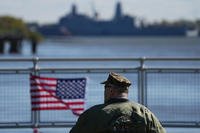The Navy has made great strides in restoring readiness, laying a foundation to increase lethality, Navy Secretary Richard V. Spencer said Wednesday.
Describing the service's "readiness hole" as so large that it stunned him when he discovered its scope after becoming secretary in 2017, Spencer said the surface Navy has taken major steps to improve training, staffing, education and maintenance.
"The spirit of 'doing more with less' produced unintended but yet completely unacceptable consequences," he said at the Surface Navy Association's annual symposium in Arlington, Virginia. "We have committed ourselves to instilling readiness and lethality across the force."
The Navy last January established a Readiness Reform and Oversight Council to continue an overhaul of surface warfare following the collisions of the guided missile destroyer USS Fitzgerald and the guided missile destroyer USS John McCain with merchant vessels in 2017.
The council was tasked to make reform recommendations and monitor their implementation.
Spencer credited the group's 111 recommendations -- 82 of which have already been implemented, he said -- as leading the surface Navy toward becoming a safer, healthier force.
Having a two-year budget plan, introduced in early 2018, that gave the military services a reprieve from budget spending limits, has contributed significantly, he added.
Now, the naval services must concentrate on lethality and long-term strength.
"The naval services are well underway to becoming strong yet again," he said.
Spencer said several recommendations being introduced fleet-wide are contributing to creating a "culture of excellence."
They include the concept of "mission command," which allows commanding officers to make decisions at the ship's level about what works best for the crew to guarantee operational excellence.
He pointed to implementing a reformed uniform readiness and certification process that has helped ensure that ships are certified before they deploy.
And he cited changes to tour lengths and manning styles, to include addressing fatigue, that ensure that personnel are effective on the job.
"These are a few of the changes that are underway as we move from immediate safety fixes, to effective operations, to the ultimate goal of enhancing our culture of operational excellence," Spencer said.
He urged the Navy to be smart with the money it has received in the past year and asked all sailors, from the deckplate to flag, to strive for excellence, "constantly challenging the assumptions to increase readiness and increase lethality."
Still, he said, the rate of change must increase. He said the Navy does not have time for "business as usual."
"We have a dangerous world out there. ... It's up to us to ensure our surface warriors have the training, have that equipment and the leadership they need to confront the dangers of this ever-changing world," Spencer said.
-- Patricia Kime can be reached at patricia.kime@gmail.com. Follow her on Twitter @patriciakime.













